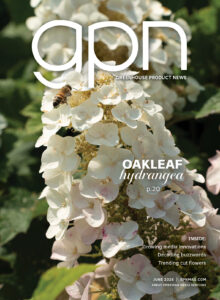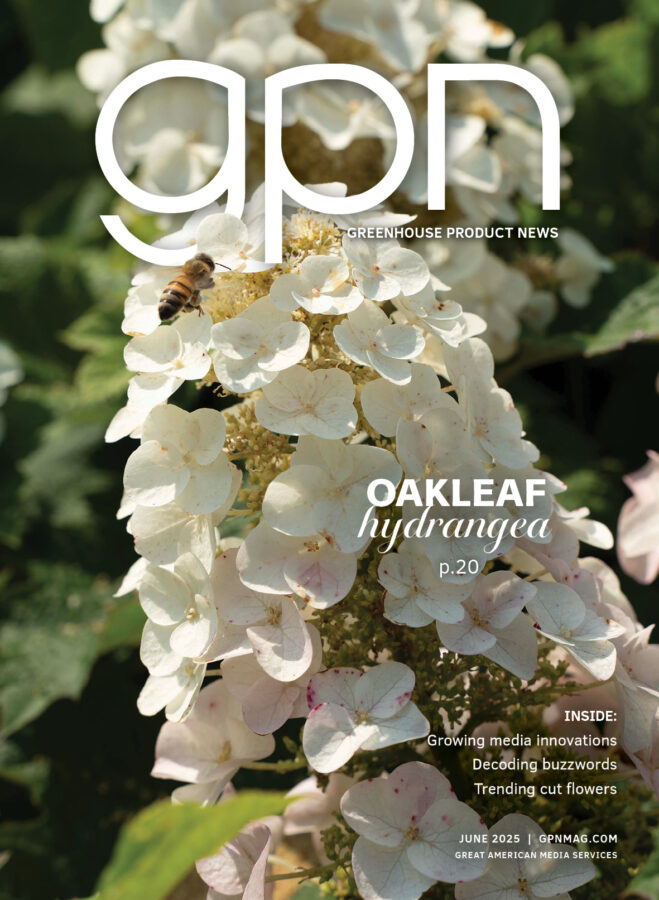Temperature and Light on Bedding Plants
Fuel prices continue to fluctuate, causing heartburn and headaches for growers as they receive their monthly fuel bills during periods of cold weather. When fuel costs are high, some growers in cold climates (such as the Northern United States) have lowered their greenhouse temperatures to reduce fuel consumption and thus reduce their monthly bill. However, the effect of such a temperature decrease on plant timing and plant quality has not been determined for many popular bedding plant species.
Last year, we began to research the effects of temperature and light intensity on four popular bedding plants: salvia ‘Vista Red’, celosia ‘Gloria Mix’, marigold ‘Bonanza Yellow’ and impatiens ‘Accent Red’. Our objectives were to determine how temperature and daily light integral influence plant growth and development of these species. From this information, we can predict how changing your environment will influence the timing and quality of your bedding plant crops.
Factors and Goals
Temperature is the main force that drives plant development. Acceptable growing temperature varies among species and between different stages of production, such as vegetative growth and flower development. The leaf unfolding rate (how many leaves develop per day or week) increases with increasing temperature until reaching a certain temperature at which the rate of growth reaches a maximum. Beyond this temperature, the plant’s leaf development rate decreases. Flowering rate is also highly regulated by temperature, and as such, knowledge of optimum temperatures is very important in the production of bedding plants.
Temperature can also affect plant quality. A plant may flower at a fast rate at high temperatures, but it may have reduced quality compared to a plant grown cooler. Grown for longer periods of time under cooler temperatures, plants generally have thicker stems, greater branching, more flowers and larger flowers.
Light serves as an important energy source for a plant, as it is vital for photosynthesis. The daily light integral (DLI) is the amount of light that a plant receives in a day over a particular area. This measurement unit is the number of moles of photons (mol) per square meter (m2) per day (d), or mol·m-2·d-1. For many floriculture crops, 10 mol·m-2·d-1 is considered an acceptable amount of light for growing moderately high-quality plants. Generally, the greater the DLI, the greater the plant quality; plants have thicker stems, more flowers and larger flowers.
Together, temperature and light intensity can interact to influence plant growth, development and quality. For example, plants grown at high temperatures with low light levels tend to be of poor quality; plants grow rapidly yet have low rates of photosynthesis. In this scenario, short production time (from higher temperatures) and less biomass (from low light levels) yield plants that have thin stems, few or no branches and small flowers. If these plants were grown at cooler temperatures, crop timing would be longer, but plant quality would be improved since plants would receive more light before reaching a particular finish date.
The possible combinations of light and temperature in bedding plants brings up many questions for researchers and growers. The goals of Michigan State University researchers were to develop simple decision support tools or models that bedding plant growers can use to predict crop timing at any given temperature and light intensity, determine how growth rates are influenced by supplemental photosynthetic lighting, and provide information on the quality of bedding plants grown under different combinations of temperature and light intensity.
What We Did
Two sets of experiments were performed to quantify the effects of DLI and temperature on 1) plug growth and development (plug stage) and 2) growth and development from the plug stage until flowering (finish stage).
In the plug stage experiments, seeds were planted into 288-cell trays and seedlings were grown in glass greenhouses ranging from 57-80° F. Within each temperature, plants were grown under three light intensities: 50 percent shadecloth, ambient light and ambient light with supplemental lighting from high-pressure sodium lamps. The daily light integrals that plants received varied from 4-251?2 mol·m-2·d-1. To give perspective about what these numbers mean, natural light levels outdoor in midsummer in East Lansing, Mich., average about 45 mol·m-2·d-1, and in midwinter average about 10 mol·m-2·d-1. Due to glazing and structures, and shading during the summer, light transmission is often reduced by about 65-75 percent. So, plants in a typical greenhouse in Michigan will receive an average of about 6-25 mol·m-2·d-1 during the year.
Data recorded for plug stage included plant height, node number, visible bud date (if flower buds were visible) and dry weight at the end of the plug stage. The plant dry weight is an indication of plant quality, as plants with thicker stems and branches will weigh more than plants with thin stems and poor branching.
In the finish stage experiments, mature plugs (all of which were grown at 75° F under 13 mol·m-2·d-1 were transplanted into 4-inch pots and grown at 57-79° F under DLIs ranging from 5-25 mol·m-2·d-1. On the day that each plant flowered, we recorded plant height, leaf (node) number, flowering date, dry weight, flower number and flower size.
Plug Stage Results
Salvia. Salvia plugs were considered finished when the second leaf pair reached approximately 1.4 inches across. At finish, all plugs under all treatments had 3 or 4 total nodes. Days to finish (time from seed sow to end of plug stage) was 22 days when grown at 80° F with an average of 25 mol·m-2·d-1 and increased to 45 days when plugs were grown at 57° F with 4 mol·m-2·d-1. Dry weight at finish was greatest with a temperature and DLI combination of 57° F and 24 mol·m-2·d-1; however, time to finish was 40 days. Plugs were of poorest quality (dry weight was lowest) when grown at 79° F and with 31?2 mol·m-2·d-1 of light, but finish time was rapid (25 days). Supplemental lighting had the greatest influence on dry weight under the coolest temperatures. Plugs were tallest under the highest temperature and lowest DLI, while plugs were shortest under the coolest temperatures and lowest DLI. Figure 2, page 34 illustrates the timing and quality differences we observed in salvia after 22 days under the various conditions.
Celosia. Celosia plugs were considered finished when their second set of leaves was approximately 1.8 inches across. Celosia finished the earliest, in 20 days, when grown very warm (82° F) and under very high light (25 mol·m-2·d-1). At 57° F and under DLIs ranging from 4-17 mol·m-2·d-1; celosia showed severe chlorosis and did not reach finish stage within 60 days, when the experiment ended. Dry weight increased in all temperatures as DLI increased. Greatest dry weight occurred at 73° F and under 24 mol·m-2·d-1. Plugs at 73 and 80° F had 6-7 leaves at finish while those at 57-68° F were more variable and had 7-11 leaves at finish.
Marigold. Marigold plugs were considered finished when the second leaf pair was approximately 1.8 inches across. Plugs under all treatments had 3 or 4 leaf pairs at finish. Shortest time to finish was 16 days observed at 79° F and under high light (24 mol·m-2·d-1). Finish time increased to 37 days at 57° F and under low light (4 mol·m-2·d-1). Dry weight increased as DLI increased in all temperatures, but DLI had the greatest effect at the coolest temperatures. Marigold height increased by 30 percent as temperature increased from 57-80° F under 4 mol·m-2·d-1 and by 15 percent under 26 mol·m-2·d-1.
Impatiens. Impatiens plugs were considered to be finished when the 6th leaf became visible; all plugs had 6-7 leaves at finish. Figure 3, page 34 shows plugs after 29 days under the various temperature and light combinations indicated. Fastest time to finish was 28 days at 81° F and under 23 mol·m-2·d-1 and was 35 days earlier than plugs grown at 57° F receiving 4 mol·m-2·d-1. Impatiens dry weight was greatest under 57° F and 26 mol·m-2·d-1, but time to finish was 38 days; impatiens had the least biomass (i.e., plant quality was poorest) at high temperatures and low light (79° F with 4 mol·m-2·d-1 of light).
Finish Stage Results
Salvia. Salvia was considered flowering when the bottom flower on the spike opened. Salvia grown for 19 days at the different temperature and light combinations are shown in Figure 1, page 32. Days to flower was hastened by 35 days (from 53-18 days) as temperature increased from 57-79° F and DLI increased from 5-26 mol·m-2·d-1. Flower number increased from an average of 4 to 8 as temperature decreased from 79-57° F. Flower size was between 1.4 and 1.9 inches for all treatments. Dry weight increased as temperature decreased and DLI increased. Temperature and DLI had no effect on node number at flowering.
Celosia. Celosia was considered in flower when flowers reached 1.6 inches in length. Days to flowering decreased from 60-26 days as temperature increased from 57-79° F and DLI increased from 4-26 mol·m-2·d-1. Plants grown at 57° F not only took the longest to flower, but also had chlorotic leaves (Figure 5, page 36). DLI accelerated time to flower for most plants grown at the coolest temperature (57° F). Celosia flower number increased as temperature decreased from 79-63° F; after this point, flower number began to decrease. Plant height increased from 6.3-11.4 inches as temperature increased from 57-79° F, and DLI decreased from 26-4 mol·m-2·d-1. Dry weight increased as DLI increased and decreased as temperature decreased.
Marigold. Marigold data was recorded when flowers were fully open. Days to flowering decreased from 43-15 days as both temperature and DLI increased (from 57° F and 5 mol·m-2·d-1 to 79° F and 26 mol·m-2·d-1) (See Figure 7, page 38). Flower size increased from 1.4-2.4 inches, and flower number increased from 11-25 as DLI increased from 5-26 mol·m-2·d-1 and temperature decreased from 79-57° F (Figure 6, page 38). All plants had four or five nodes at finish. Plant height at flowering decreased from 5.5-4.3 inches as temperature decreased from 79-57° F and DLI decreased from 26-5 mol·m-2·d-1. Dry weight increased the most at cooler temperatures (57 and 63° F) as DLI increased from 5-26 mol·m-2·d-1.
Impatiens. When petals of the first open flower were fully expanded, impatiens were considered to be in flower. Days to flower increased from 22-38 days as temperature decreased from 79-57° F. DLI accelerated flowering the most when grown at 57° F. Flower size increased from 1.6-2.4 inches and flower number increased from averages of 14-95 as temperature decreased 57-79° F and DLI increased from 5-26 mol·m-2·d-1. Dry weight increased by 85 percent as temperature decreased from 79-57° F and DLI increased from 5-26 mol·m-2·d-1.
Conclusions
As expected, plants developed quickest at the plug stage and finish stage when grown warm (approximately 80° F) and under high light. Plant quality was generally poor when grown warm with low light levels. For impatiens, marigold and salvia, plants were of highest quality when grown at cool temperatures with high light levels. In contrast, celosia was chlorotic at the coolest temperatures, and thus celosia should be grown at moderate to high temperatures (greater than 68° F) for highest plant quality.
Figure 4, page 36 presents a summary of time to flower (from the plug stage) at some common greenhouse temperatures and with two very different light levels. This information can be used by growers to determine the impact of changing their greenhouse temperature in the winter (when light levels are low) and later on in spring (when light levels are relatively high). Growers will have to determine how to balance timing with plant quality, as the highest-quality plants are those grown at moderate to cool temperatures, which require more time compared with plants grown at warm temperatures.
The authors would like to thank Raker’s Acres for donation of the plant material and the generous industry supporters who made this research possible.









 Video Library
Video Library 


















